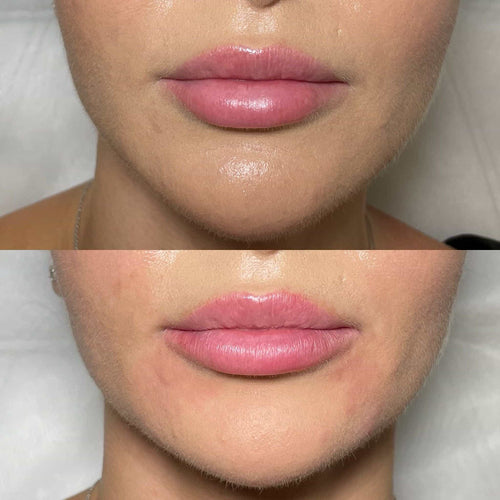Book a Dermal Filler Appointment with Dr. Laura Geige at It’s Me and You Clinic
Understanding Swelling After Lip Filler
What Causes Swelling?
Lip filler swelling is a common and expected side effect after lip augmentation procedures. It occurs as a natural part of the body’s inflammatory response to the introduction of foreign material (the filler) into the lips.
When filler is injected, it disrupts the tissues and triggers the release of histamines and other inflammatory mediators. These substances cause blood vessels to dilate, increasing blood flow to the area. This increased blood flow contributes to swelling and redness.
Additionally, the filler itself can also directly contribute to swelling. As the filler molecules spread within the lips, they can displace and compress surrounding tissues, leading to fluid buildup and puffiness.
The severity of swelling varies depending on several factors, including:
*
The type and amount of filler used
*
The skill and experience of the injector
*
Individual patient characteristics, such as skin thickness and metabolism
Most patients experience peak swelling within 24-48 hours after treatment. The swelling gradually subsides over the following days and weeks.
While some degree of swelling is normal, excessive or persistent swelling could indicate a complication, such as an allergic reaction or infection. If you experience severe or concerning swelling, it’s essential to contact your injector immediately.
Timeline of Swelling
Swelling is a common side effect after lip filler injections, and understanding its expected timeline can help manage your expectations and care for your lips during recovery.
Immediately after the procedure, you’ll likely notice immediate swelling as a reaction to the injections. This initial swelling peaks within 24-72 hours post-treatment and is usually most prominent at the injection sites.
Over the next few days, the swelling gradually subsides. By day three to five, most of the noticeable swelling should have reduced, but some mild puffiness may still be present.
It typically takes around a week for the majority of swelling to disappear completely. However, individual healing times can vary depending on factors like the amount of filler injected, your metabolism, and overall health.
While most swelling subsides within a week, some minimal puffiness might linger for up to two weeks. This is perfectly normal and usually fades away without intervention.
It’s important to note that bruising is also common after lip fillers, which can contribute to the overall appearance of swelling. Bruising typically resolves within 7-10 days.
Factors Influencing Swelling
Injection Technique
Swelling following lip filler injections is a common and expected side effect. The degree of swelling varies significantly from person to person and can be influenced by several factors.
One major factor is the amount and type of filler used. Larger volumes of hyaluronic acid fillers generally lead to more pronounced swelling compared to smaller doses.
The injection technique also plays a crucial role in determining swelling. Deeper injections tend to produce less noticeable swelling than superficial ones, as deeper tissue has fewer blood vessels and lymphatic channels.
Individual patient characteristics also contribute to swelling variability. Factors like skin thickness, age (thinner skin with aging may swell more), and underlying medical conditions can all influence how much a person swells.
Lifestyle factors can also affect post-injection swelling. For example, strenuous exercise or exposure to extreme temperatures can exacerbate inflammation.
Some individuals may be more prone to swelling due to their body’s natural inflammatory response.
Proper injection technique is essential for minimizing unnecessary swelling. Injecting the filler evenly and gently into the desired areas helps distribute it properly and reduces trauma to surrounding tissues.
Following specific post-injection care instructions provided by your practitioner is crucial for managing swelling. This may include avoiding certain activities, applying ice packs, and elevating the head while sleeping.
Individual Healing Processes
Swelling after lip filler injections is a common and typically temporary side effect. Several factors influence the extent and duration of this swelling.
**Factors Influencing Swelling:**
- Injection Technique: The depth, placement, and volume of filler injected can all impact swelling. Deeper injections tend to result in more pronounced swelling.
- Filler Type: Different hyaluronic acid (HA) fillers have varying viscosities (thickness). Thicker fillers may cause more initial swelling, but the swelling often resolves faster.
- Individual Anatomy:** People’s facial structures and skin thickness vary. Those with thinner skin or a tendency towards fluid retention may experience more noticeable swelling.
- Patient-Related Factors:
- Smoking:**
- Alcohol Consumption:**
- Medications:**** Some medications, such as blood thinners, may affect the body’s inflammatory response and influence swelling.
- Allergies or Sensitivities:
Nicotine constricts blood vessels, potentially delaying the dissipation of swelling.
Alcohol can increase inflammation and prolong swelling.
Arrange a Dermal Filler Consultation at It’s Me and You Clinic with Dr. Laura GeigeAn allergic reaction to the filler ingredients could lead to increased swelling. **
- Post-Injection Care:**** Following a provider’s instructions carefully is crucial. Avoiding excessive sun exposure, heat, and strenuous activity can minimize swelling.
**Individual Healing Processes:**
Healing time after lip filler injections varies significantly from person to person. Factors influencing individual healing include:

- Age: Younger skin tends to heal faster.
- Overall Health:**
- Skin Type:**
Chronic conditions or weakened immune systems may affect the healing process.
Individuals with oily or acne-prone skin may experience different healing rates compared to those with dry or sensitive skin.
It’s important to remember that swelling is a normal part of the healing process and usually subsides within a few days to a week. However, if you experience excessive or prolonged swelling, unusual bruising, pain, redness, or any other concerning symptoms after lip filler injections, consult your provider immediately.
Managing Lip Filler Swelling
Cold Compresses
Lip filler swelling is a common side effect and typically peaks within 24-48 hours post-treatment. Most swelling subsides significantly within a week, with minimal residual swelling lasting up to two weeks.
While some swelling is expected, excessive or prolonged swelling can be concerning. Here’s how to manage lip filler swelling effectively:
* **Cold Compresses:**
Applying cold compresses immediately after treatment and for the first 24-48 hours can significantly minimize swelling.
-
Use a clean, cold compress (ice pack wrapped in a towel) and apply it to your lips for 15-20 minutes at a time, several times a day.
-
Avoid applying ice directly to the skin, as this can cause further irritation and damage.
Book a Dermal Filler Appointment with Dr. Laura Geige at It’s Me and You Clinic
* **Elevating Your Head:** Sleeping with your head slightly elevated can help reduce swelling by promoting blood flow away from your face.
Use an extra pillow or two to prop up your head while sleeping.
*
Avoid Heat and Sun Exposure:
Heat and sun exposure can worsen inflammation and swelling.
-
Minimize time in hot showers or baths, especially during the first few days after treatment.
-
Protect your lips from the sun with a broad-spectrum sunscreen (SPF 30 or higher) and wear a hat for additional protection.
*
Hydrate:
Drinking plenty of water helps flush out toxins and reduces overall inflammation.
*
Avoid Alcohol and Smoking:
These substances can dehydrate you, worsen inflammation, and slow down the healing process.
If you experience excessive swelling, pain, or other concerning symptoms after lip filler treatment, contact your injector immediately.
Hydration
Understanding how much swelling is normal after lip filler injections is crucial for managing expectations and ensuring a smooth recovery.
Generally, some swelling is expected after any cosmetic injection, including lip fillers. The amount of swelling varies depending on factors like the amount of filler injected, individual anatomy, and skin thickness.
Here’s what you can expect:
-
Immediately after treatment: Mild to moderate swelling is common. The lips may feel tender, firm, and look visibly larger than their usual size.
-
Within the first 24-48 hours: Swelling peaks and reaches its maximum point. This is when your lips will be most noticeably swollen and potentially uncomfortable.
-
Day 3-7: Swelling starts to gradually subside, though it may still be noticeable. Your lips should feel less tender and more comfortable.
-
Week 1-2: Most swelling has resolved. The final shape of the lips begins to appear.
-
Beyond Week 2: Any remaining minor swelling should dissipate completely.
While some degree of swelling is expected, excessive or prolonged swelling may indicate a complication and requires attention from your injector.
Managing Lip Filler Swelling:
-
Ice Packs: Applying ice packs for 15-20 minutes at a time can help minimize swelling in the first 48 hours.
-
Elevation: Keeping your head elevated while sleeping can reduce fluid buildup.
-
Hydration: Drinking plenty of water helps flush out excess fluids and promotes healing.
-
Avoid Alcohol:** Alcohol is a vasodilator, meaning it widens blood vessels, which can worsen swelling.
-
Minimize Sun Exposure: UV rays can increase inflammation and slow down healing.
Remember that every individual heals differently. Following your injector’s post-treatment instructions is essential for optimal results and a safe recovery.
Josie Barrett Carmen Alexandra Your Relationship Edge Kurious Kittens
- How To Build Lasting Connections Beyond Traditional Norms - May 20, 2025
- Biromanticism And When Romantic And Sexual Attraction Don’t Align - May 19, 2025
- THC-Infused Seltzers: A Trend Worth Trying - May 19, 2025
